Menu
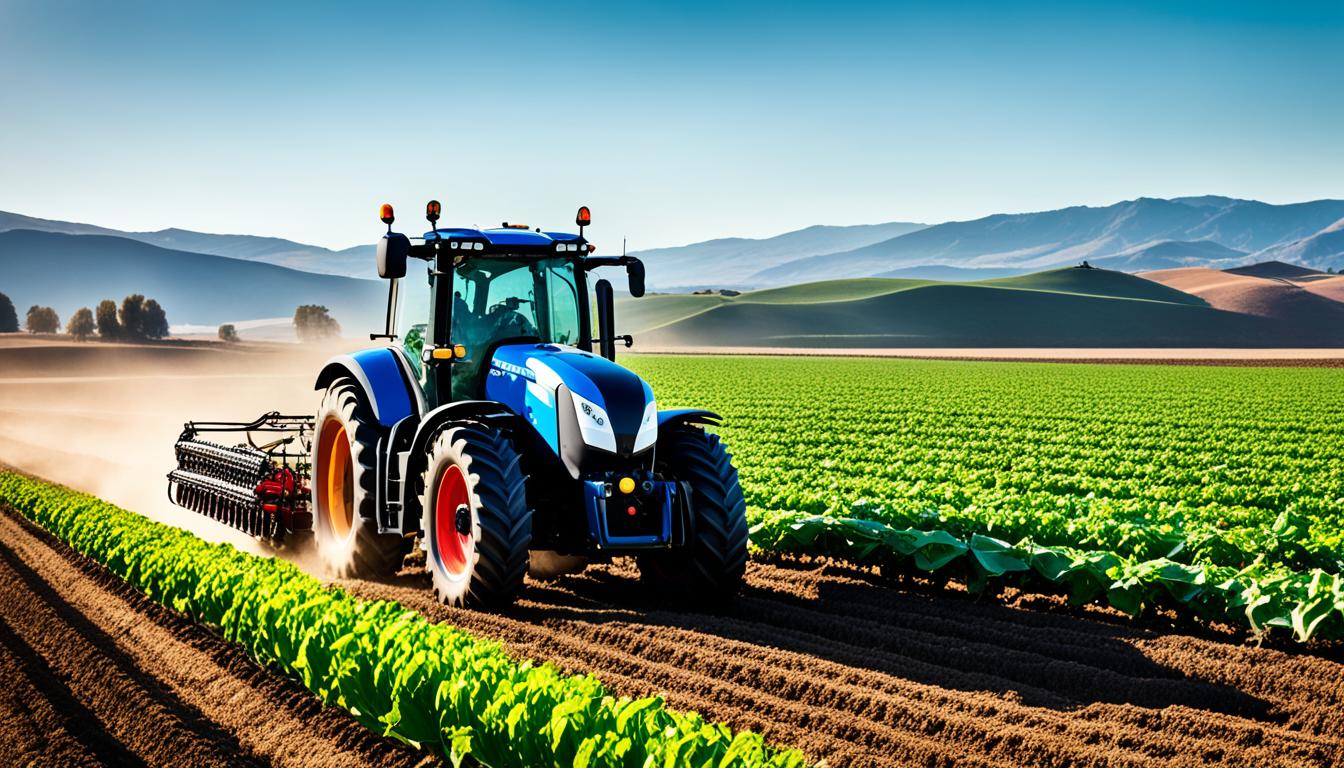
What changes will the rise of autonomous farm machinery bring to farm safety? This is a key question with the advancement of AI-driven tools in agriculture.
Farming has quickly adopted AI and automation, leading to big improvements in how efficiently farms can work. Now we have self-driving tractors, weed-killing robots, and smart methods to gather data. These bring great hope to farming but also raise serious safety challenges.
The University of Illinois has deeply studied how to make sure autonomous farming machines are used safely. They looked at reviews of over 60 research papers. Experts highlight key areas like understanding the environment, evaluating risks, and considering how people interact with these tools. Salah Issa from UIUC’s Agricultural Safety and Health Program pushes for strong safety measures to support the use of this machinery.
Exploring the history of autonomous farming machinery shows a world changed by constant improvement. This journey takes us from simple machines to advanced, AI-powered tractors. Scholars Issa and Aby highlight the move towards using many sensors and aiming for high safety standards.
The story of autonomous farm machinery starts with the first steps in mechanisation. It has evolved into using AI and robots. Now, we see tractors equipped with 3D scanners, ultrasonics, and high-quality cameras. These machines can work alone, needing little human help.
TYM’s work since 2013 in producing self-driving tractors shows the field’s progress. Their latest tractor is at the top level for precision in Korea. It proves how AI and farming equipment blend perfectly.
The use of agricultural robots brings huge improvements in work and worker safety. It boosts how much farmers produce. It also makes harvests more accurate and decreases mistakes.
These machines make farms safer by keeping people from dangerous tasks. They use sensors to keep a close watch on risks. Important studies from places like the University of Illinois are looking into these safety features.
They also help protect the environment by making farming practices more sustainable. Less manual work means saving resources and reducing waste. Using drones for crop and soil checks shows the big wins of using these advanced tools.
By 2050, the global population may hit 9.8 billion. This will put a big demand on farming to grow more food. AI in agriculture helps by predicting the best farming steps. It also spots crop problems before they spread. These advances make farming smarter and more efficient.
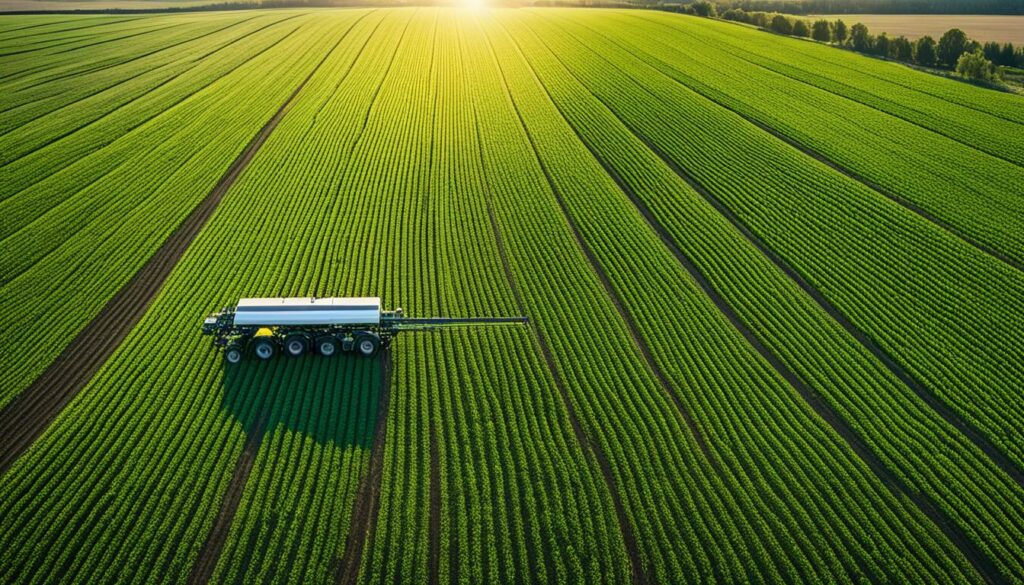
AI drives technologies like precision farming. This tech makes farming more efficient which leads to better crop quality. It also reduces waste. AI can track the health of crops in real-time. This helps farmers with decisions on resources and work.
AI also tackles big challenges in farming. It deals with the limited resources and the harm to nature. With AI, the future of farming looks greener and healthier. This is because AI helps make the best use of what’s at hand.
Big names like John Deere and New Holland lead in making machines that can farm by themselves. These machines plant, harvest, and even handle weeds without much help. FarmSense’s tool, FlightSensor, is especially clever. It uses bugs’ signals to spot crop issues early.
AI also fine-tunes how crops are watered, fed, and protected from bugs. This smart farming makes sure resources are used well. It includes tools like Crop Prophet, which predicts grain yields with great accuracy. With AI, farming is becoming less risky and more predictable.
Adopting AI in farming isn’t easy. Current machines may not fully support AI’s new tricks. Also, rules need to catch up with the latest farming tech. These are big hurdles for smart farming.
Yet, the future of farming lies in joining forces. Governments, businesses, and people must work together. This teamwork can make farming better for everyone. AI can help farms deal with climate change and still produce plenty of food. It’s all about using resources wisely and working smarter.
Understanding how the environment looks is key for safe farming with autonomous machines. These machines use special sensors to see and move around fields accurately.
Perception sensors act as the ‘eyes’ for these machines. They help them understand the world around them. Examples of these sensors are:
When machines use a mix of these sensors, they get a full view of their environment. This is vital for safe farming.
Machine learning is crucial for these machines to detect obstacles. It helps them react quickly to what’s in front of them. This keeps everything running smoothly and safely.
Experts are using more and more sensors to make obstacle detection even better.
In the field, machines meet several types of barriers. Some common ones are:
Good perception of the environment helps avoid accidents. It’s crucial for the safety and efficiency of these machines.
The safety of autonomous farming machines is crucial as the world’s population grows. By 2100, we could see 10.9 billion people. Lots of research has looked into making these machines safe. They stress the need for careful risk assessment and strategies to reduce risks because we have little past data on these systems.
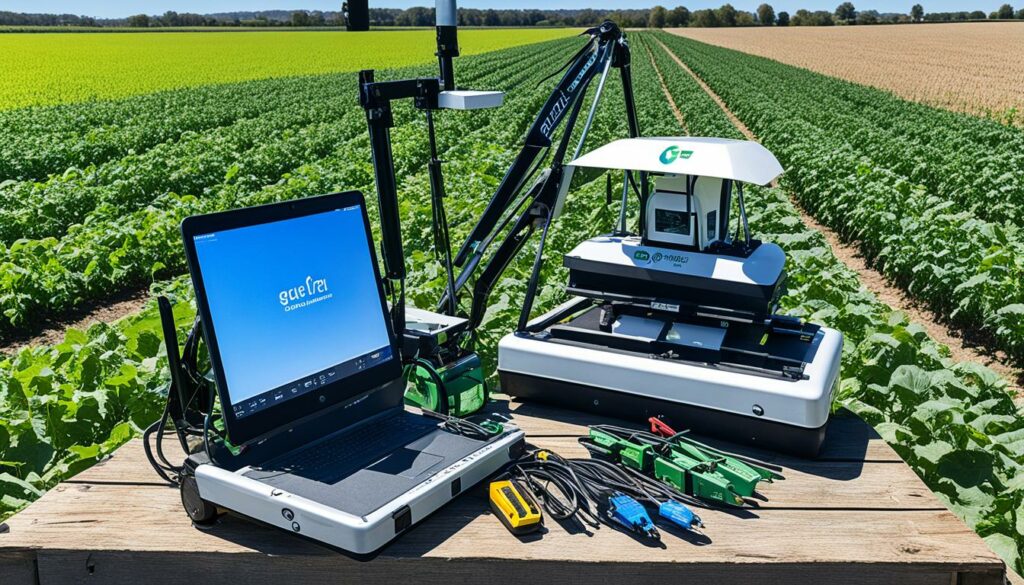
Today, we focus on finding hazards before they cause any harm in farming machines. A review of 152 papers on weed control and 77 on robots working together shows this. Most studies – 48 out of 62 – look at how well these machines understand their environment. Knowing this helps make them safer.
Countering the unknown in farming machines needs good risk reduction plans. These should include watching risks in real-time and being ready to change how machines work. The rules for using these machines safely must also be updated. This is key for their best and safest use.
The use of automated systems in agriculture is growing. This change means we have to look closer at how people work in farming. I found many studies that show how important it is to design tools in a way that fits with people, especially when they work near robots. This design helps keep people safe while working more efficiently.
It’s key to know about how humans and robots can work safely together. There hasn’t been enough research on this topic. It’s vital to create robots that work well alongside people, not against them. This approach reduces the chances of accidents and improves how people and machines can work as a team.
Designing things well for people in farming is very important. Studies show that making tools easy to use and adjust can make work safer. Workshops have suggested making machines that can be changed to fit different workers and that are easy to use.
Having engineers and farming experts work together is crucial. They can make tools that focus on people’s needs and work well with the humans on the farm. This way, keeping everyone safe and making the farm more efficient are top goals.
| Key Areas | Importance |
|---|---|
| Human-Robot Interactions | Ensures seamless integration and safety |
| Ergonomic Design | Promotes user-friendly and adaptable machinery |
The world of farming safety standards is always changing. With new autonomous farming machinery, we have to update these rules. The rise of machines that work on their own adds complexity to keeping everyone safe.
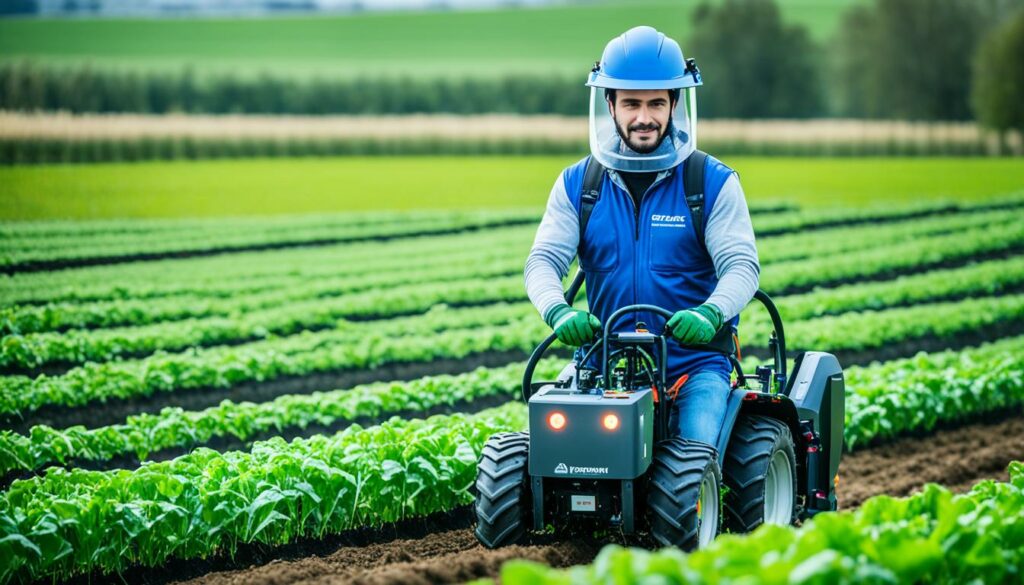
Many safety rules were made before machines could work without people. This means there aren’t enough rules for the new AI machines. But, many experts are looking into this and they find we need more than the old rules to be safe.
OSHA makes sure farming safety standards are followed. In places like California, OSHA requires rules for being safe around these new machines. These rules are important to keep people safe while using this new technology.Each state also has its own safety rules for farming. For example, there are special licenses for using certain chemicals. This shows how we need different rules to protect both people and the environment.
| Country | Publications on Autonomous Safety |
|---|---|
| Denmark | 10 |
| USA | 8 |
| Italy | 8 |
| China | 8 |
| Germany | 4 |
| Australia | 3 |
| Japan | 3 |
| Canada | 3 |
We expect the world’s population to grow fast, hitting 8.5 billion by 2030. This means we need to farm better and safer. Using machines that can farm on their own is part of the solution. But, we must make sure these machines are used safely and sustainably.
Looking at how autonomous machinery is used in farming gives us lots of useful information. By 2030, we’ll have 8.5 billion people to feed. This makes it crucial to farm efficiently and safely. Case studies on farm automation show its great potential and why safety is key.
Many farming tasks are now done by autonomous machines. For instance, there’s a big leap in robots that pull out weeds on their own. These machines are getting more and more precise thanks to new tech like LiDAR and advanced sensors.
Cooperative robots, or ‘cobots’, are also making a big difference. They’ve been found to make farms more efficient in the US, Italy, Denmark, and China. These robots use advanced cameras and sensors to see the world better and work smarter.
We’ve learned a lot about keeping autonomous farms safe from both successful and challenging projects. For one, making sure these machines can ‘see’ the world around them well is a must. Many studies have focused on making this kind of technology safer.
Over 62 pieces of work have looked into how to make autonomous farming machines safer. 48 of these focused on how these machines see the world. Another 9 looked into risks and how to lower them. This shows just how important it is to design safety well for how these machines work.
Also, getting everyone involved to work together has been shown to be crucial for these projects to do well. Collaboration is key for a successful autonomous farming future.
“Ensuring the safe integration of autonomous systems is non-negotiable, as underscored by numerous case studies and research reviews. Their success is determined not only by technological prowess but also by the robustness of safety protocols and engaged leadership.” – Agricultural Safety Expert
The vast amount of research in this field shows how much we care about it. Everyone, from scholars to those working the land, is contributing. As we keep moving forward, getting better at safety, ‘seeing’ the environment, and working together is vital. Learning from the successes and challenges of autonomous farming can guide us to a safer and more efficient agriculture.
Autonomous tractors combine the latest robotic technology with farming. Since 2013, TYM has led in making self-driving tractors that are simple to use. Their 2021 model in Korea was incredibly precise. These machines reflect the opportunities in robotic farming. They promise to change farming by making it more efficient and precise.
Autonomous tractors hold the potential for huge change. They let farming run 24/7 during key times like planting and harvesting. This is important as we aim for farms to use resources better against climate issues. John Deere’s model 8R 410 and others offer a lot of power and new features, but they are costly.
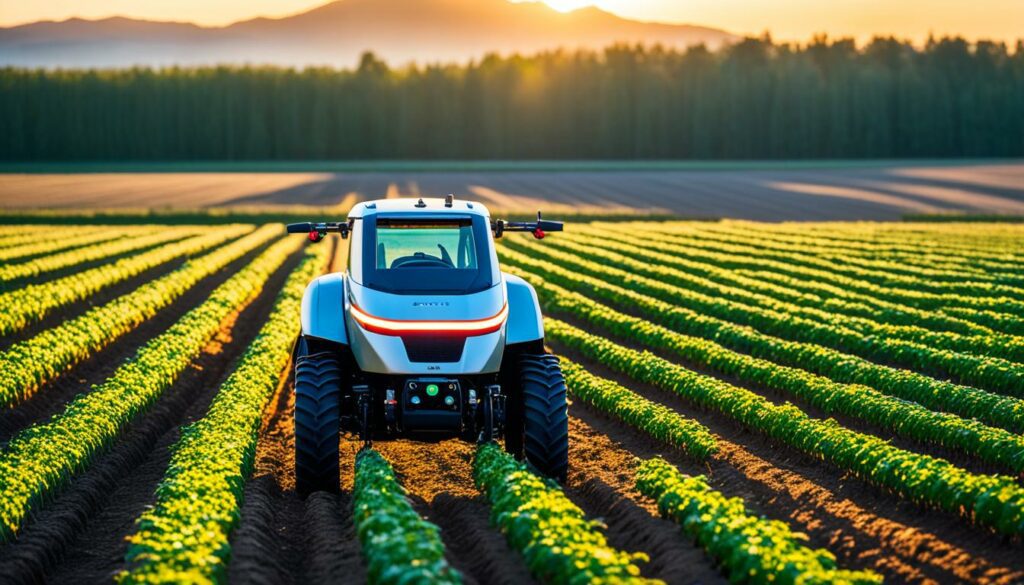
These tractors also gather important data on the soil, the crops, and the best times to farm. This lessens the need for skilled workers and could make food cheaper. They are especially popular with young people, who like the idea of using high tech in farming.
Safety protocols for autonomous farming are a must. These tractors are built with many safety features. For instance, they turn off the engine if they lose their signal or veer off course. This stops accidents, often caused by tired drivers. TYM’s tractors also use top-notch sensors for live monitoring. This helps with making farming better through constant research.
Take Yanmar’s YT5115N, for example. It uses lidar and special cameras to move around more safely. This makes the tractors work longer, finish tasks quicker, and use less fuel. These advancements cut the costs of running the tractors, showing how much opportunities in robotic farming there are.
| Model | Horsepower | Price Range |
|---|---|---|
| John Deere 8R 410 | 177-405 | $500,000-$800,000 |
| Fendt 1000 Vario | 112-517 | N/A |
| Monarch Tractor MK-V | 250 | $50,000 |
| Yanmar YT5115N | N/A | N/A |
Smart farming tech is changing agriculture as we know it. It includes AI, remote sensors, and precise methods. These new tools promise to make farms more efficient and productive.
Drones and UAVs are top tech for farming now. They check on crops, help plant, and map fields. By using GPS and smart learning, they cut costs and improve how we farm. For example, John Deere and Volocopter made a large drone for farm use. It runs on electricity and lasts up to 30 minutes in the air.
Precision farming lets farmers use data and tools for better choices. This helps increase production and lower harm to the environment. Monarch Tractor is leading this field with a tractor that drives itself.
The future of farming tech lies in precision agriculture. With better learning programs, farms will be safer and work smarter. This will help lower the high accident rates in farming.
New farming tech means we need new safety rules. California, for instance, is discussing how to keep up with self-driving farm machines. It’s important to have modern rules that fit new farming technology.
| Company | Technology | Impact |
|---|---|---|
| Monarch Tractor | Autonomous Tractor | Increased Productivity |
| John Deere & Volocopter | 9.2m Drone | Enhanced Efficiency |
| Multiple Companies | Autonomous Farm Machinery | Improved Safety |
Precision agriculture has changed farming by using data to boost crop yield and streamline work. Yet, these changes also raise crucial safety issues. As farmers use new methods, keeping up safety standards is very important. It’s key to make sure workers’ safety doesn’t suffer even as farms get more produced.
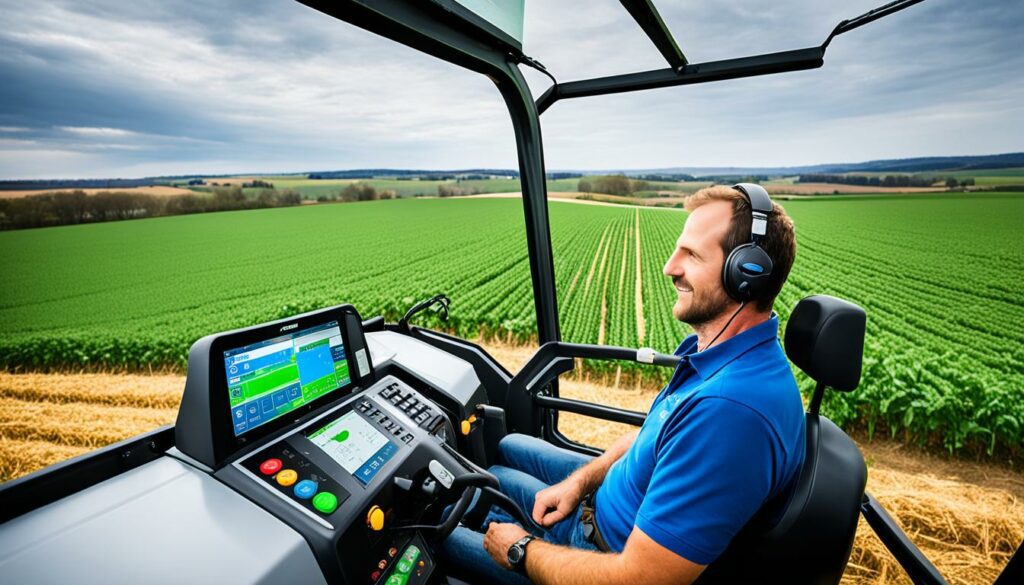
Precision agriculture brings many advantages. It makes farming less labour-intensive, saving costs and time. This means more work done well, thanks to machines working all hours. Farming tech also lets us harvest crops at the best times, improving quality. With automation and machine learning, farmers can harvest more efficiently and quickly.
It’s good for the planet too. Precision farming uses fewer chemicals and saves water and soil. The technology often runs on clean energy, cutting down on farming’s carbon footprint. This is a big win for the Earth.
Safety is crucial in precision farming, despite its many pluses. It’s vital for the well-being of farm workers. With less manual labour, the risk of overwork and exposure to toxins drops. But, it’s still important to check and fix any new risks that might come up. Following strict safety rules is essential to keep farm tech working well and safely.
Precision agriculture uses high-tech tools like GPS and learns from machines to fine-tune jobs. Drones and UAVs are key in this, doing jobs that help plants thrive. Having strong safety plans for these new tools is a must. This keeps everyone safe as we use these technologies.
All in all, precision agriculture is a game changer. It offers more profit, less waste, and a cleaner environment. Still, getting over some hurdles like cost and data sharing is necessary. Helping farms with money, ideas, and better ways to share data will help more farms benefit from these new techs.
Keeping autonomous farming machinery safe needs a careful plan. This includes many safety steps and spotting usual safety mistakes. Doing this helps in preventing agriculture accidents and tackling common safety issues in farming.
The key for both makers and users is to follow safety steps like ISO 18497. They use intense sensors and good design to keep danger low. The University of Illinois says using many sensors, like 3D laser scanners, helps machines see and move well, which cuts risks.
Designing machines to work well with people is also crucial. They should be safe and comfy to use. Monarch Tractor in Livermore, Calif., shows this with their tests that keep people away from the machines when spraying pesticides or weeding.
Yet, some safety issues still stick around due to autonomous machinery safety measures. About 232 farm workers died each year from 2017 to 2021, showing we need to do more. One big issue is when sensors don’t work right, making machines take wrong paths or miss hazards. So, machines need regular checks and tech updates.
The human part is also a big challenge. Mistakes by people, even with the best machines, can be dangerous. That’s why we must train operators well. They need to know what the machines can and can’t do.
Tackling these issues and keeping up with autonomous machinery safety measures can change a lot. We can do more to stop accidents and make farms safer.
The rise of unmanned agricultural vehicles has brought a big change to farming. They help solve many of the challenges farmers face. With the Earth’s population growing, we need better ways to farm. By 2030, we’ll reach 8.5 billion people. By 2050, this number will jump to 9.7 billion, and by 2100, it’s expected to hit 10.9 billion. To feed everyone, we must find farming solutions that work well and can be used on a big scale. Unmanned vehicles, like self-driving tractors, drones, and robotic milking systems, are a step towards making farming more productive and efficient.
Today, we see a variety of unmanned agricultural vehicles in action. For example, John Deere’s autonomous 8R tractor can do many jobs by itself. Big drones are also used to spread pesticides, cutting down on the need for human workers and keeping them away from harmful chemicals. Lely’s robotic milking machines show how automation can make precise, reliable tasks easier. Each of these machines offers different ways to help in farming.
The perks of unmanned agricultural vehicles come with some safety worries. The University of Illinois warns that the safety of these machines depends on their ability to see the environment around them. Systems that use sensors and AI to spot and avoid obstacles are key to preventing accidents. Rules in places like California say there must be people nearby when these machines work. This is to make sure they’re safe. But, these rules might slow down the use of new farming tech. This shows the challenge of keeping up technological progress without compromising safety.
Using these vehicles safely in farming requires careful checks and clear rules. Laws need to change to allow for the smooth use of autonomous farming gear. Making sure these new farming tools are safe builds trust in technology. It also lays the groundwork for a farming future that’s more effective and better for the environment.
It’s vital to use AI-driven machines safely. This prevents accidents and ensures more reliable work. It also helps farms become more efficient and productive with these new technologies.
Autonomous machines started as simple tools. They’ve grown into complex systems with AI and robots. These advancements have changed farming from manual to precise, high-tech processes.
Using these machines boosts how much we can grow. It makes farm work safer by avoiding dangerous tasks. These devices also make farming more exact, improving crop yield and cutting down on labour needed.
AI in farming uses learning algorithms, sensors for understanding the environment, and real-time data analysis. This helps machines work better and more efficiently on the farm.
Challenges with AI in farming include old machines not keeping up, needing new laws for these innovations, and making sure AI can really understand and handle farming’s complex situations.
Sensors like 3D laser scanners and thermal cameras are common. They help autonomous machines see obstacles and move around them safely.
Machine learning looks at sensor data to find and understand obstacles. It can predict where they will move and help avoid crashes, making operations safer and smoother.
Machines need to spot things like fences, holes, and moving animals or vehicles. Detecting these can prevent serious accidents, making the farm safer.
Current methods for checking risks include thinking ahead about what might go wrong, using computer models, and looking at data as it happens. All these techniques aim to make farming with AI safer.
Mitigating risks includes having clear safety rules, systems that check things in real time, and smart control systems. Regular checks are also key to keeping operations safe.
It’s really important to design machines that work well with people. This is crucial for safety, especially when humans and robots are working near each other on the farm.
To make machinery that’s easy to use and doesn’t tire people out, design should focus on simplicity and accessibility. Operators should find it easy to understand and use the machines.
Rules for keeping these machines safe are still being worked on, with groups like OSHA helping out. Their job is to make sure these high-tech farm helpers are as safe as possible.
OSHA and the states lay down the safety rules for using these new machines. This keeps workers and the land they’re working on safe, meeting high safety standards.
Success stories from around the world show how well machines like these can work with the right planning and by working closely with farmers. They make farming more efficient, safer, and productive.
From these stories, we’ve learned how vital it is to have special safety plans, teach people how to use the machines, and to have strong rules to follow. These keep the high-tech farm helpers from causing harm.
Autonomous tractors offer many good chances in farming, like being more exact and getting more done with fewer people. But, making sure they do all this safely and with proper plans is a big challenge.
For tractors to be safe, their users need to be well-trained. They also need safety systems that work right away and checks that keep the machines running safely.
New ideas in smart farming include powerful AI for understanding data, tools that check things from far away, and machines that work by themselves better. All these are helping to farm smarter and safer.
The future of farming tech looks very promising. It should make farming even more precise, effective, and kind to our planet. But, making sure it’s all used safely and well is still very important.
Using precise tech in farming can make work more productive and protect people better from work dangers. But, it’s crucial that everyone working with these new tools is careful and well-trained.
The key safety points in using high-tech farming are to use the technology the right way, keep the equipment in good shape, teach people how to use it, and follow safety updates. This helps avoid possible accidents.
For machines that work mostly on their own, it’s important to check for risks, have the best sensors, maintain them regularly, and make sure people know how to use them right. This keeps the work running well and safe.
Things that often go wrong include sensors not working, not checking for all risks, not teaching people enough, and not having strong enough rules. All of these mistakes can lead to accidents and the machines not working like they should.
Farmers are using all sorts of high-tech helpers, from tractors that work by themselves to robots that pull out unwanted plants, and drones that keep an eye on how the crops are doing.
Keeping people safe from these advanced tools means looking out for the risks of them bumping into people or things, breaking down, and making sure they work well with the farmers using them. This needs careful planning and following strict rules.